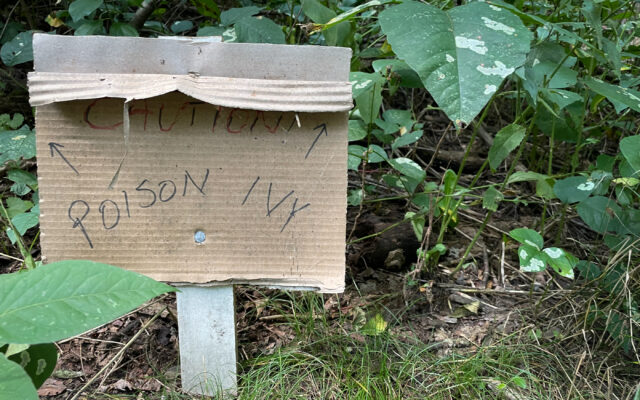
Things that can ruin a Maine hike and how to deal with them
By Aislinn Sarnacki
The online trail description warned about abundant poison ivy, so my mom and I were on the lookout as soon as we entered the woods.
On my short list of things to avoid in the Maine woods, poison ivy is underlined and bold. If touched, the oil that coats the plant’s leaves can cause an itchy rash that can last for several days. In serious cases, the rash can even cause scarring.
“Do you know what poison ivy looks like?” I asked my mom as we followed the wide trail.
“Sort of?” she replied.
The same was true for me. I’d read about poison ivy and studied photos of it. I’d even interviewed a botanist to write an article about it. Yet I still wasn’t confident that I could spot the harmful plant in a sea of understory flora. And judging by conversations I’ve had with fellow hikers, I think that’s the case for a lot of people.
Lucky for my mom and me, trail maintenance had posted a sign near a bunch of poison ivy growing trailside not far from the parking lot. There it was: a plant with three leaves growing side by side, with the stem leading to the middle leaf longer than the stems leading to the leaves to either side.
One of the reasons poison ivy is so easily overlooked is because it’s not spectacular or distinctive. It’s just a leafy plant, and it varies a bit in appearance. Sometimes the leaves are a bit jagged along the edges, and sometimes the margins are smooth. Sometimes they’re oily looking, and sometimes they’re dull. Sometimes it’s an upright plant, other times it’s more of a vine.
My only advice is to study lots of photos of poison ivy, and if you notice plants that have three leaves side by side — with a longer stem on the middle leaf — steer clear. If you brush up against poison ivy, wash your skin with soap and water as soon as possible, and be careful not to spread the oil around. You can carry a poison ivy wash if you’re especially concerned.
As I followed the riverside trail, keeping an eye out for more poison ivy, I got to thinking. What other things in nature are a nuisance to people hiking in Maine?
“Stinging nettle likes to grow near rivers, too,” I called out to my mom. “That’s the worst. It makes you start itching like mad right away.”
I’d once waded through tall stinging nettle plants while hiking along Sandy Stream in Unity, and I thought my legs were on fire. Fortunately, the rash caused by stinging nettle goes away quickly. But while it lasted, I wanted to claw my skin off.
Also on the list of things I avoid in the Maine wilderness are porcupines, also known as quill pigs.
Porcupines are shy, adorable creatures, but it’s a real problem if your dog decides to wrestle with one. Covered in thousands of sharp quills, porcupines can quickly turn your dog into a pin cushion, which will likely result in an emergency trip to the veterinarian. Believe me, I know. It happened to my former dog, Oreo, twice, right in my own backyard. That’s one of the many reasons I keep any dog I’m caring for on leash. However, if I’m hiking dog-free, I love spotting a porcupine as it waddles across the forest floor or clambers up a tree.
Number three on my steer-clear-of list, and by far the most dangerous, is the deer tick. Often no bigger than a freckle, the deer tick is a pest that carries a cocktail of diseases. And it can pass these diseases to humans (and pets) through a bite.
Deer ticks are found throughout Maine, though they’re more abundant in the south and along the coast. They tend to be most active in the spring and fall, and they’re more numerous in dense foliage and leaf litter, where they can find shelter from the sun.
You can protect yourself from ticks by avoiding those tick-heavy habitats. You can also wear repellent and clothing that covers your skin. And it’s important to always thoroughly check your body for ticks after every outing.
Lastly, biting flies such as mosquitoes and black flies have spoiled my hikes multiple times — but only because I wasn’t prepared. Insect repellent is my number one defense against these pests. Often I carry multiple types of repellent, starting with a natural variety and upgrading to a repellent with DEET if the bugs are really bad.
It also helps to wear clothing that covers as much skin as possible. On hot days, this is difficult. I like to wear shorts and short sleeves. But when the weather cools — for example at night around a campfire — I cover up. Plus I find that wearing a baseball cap keeps deer flies from biting my head, while glasses prevents black flies from diving into my eyes. (I’m not sure why they do that.)
I’m sure there are plenty of other things in nature that could potentially make a hike less enjoyable, but those are the things that I’ve had the most personal experience with: rash-inducing plants, porcupines, ticks and biting flies.
In the Maine outdoors, there are very few dangerous animals or plants. We don’t have any poisonous snakes. Our black bears and other large mammals usually flee from humans. We’ve got a few poisonous mushrooms, but you’ll be all set if you don’t eat them. All in all, the wilderness is a very safe place.
I’d hate for one bad experience with mosquitoes or poison ivy to deter someone from enjoying all the Maine outdoors has to offer. With just a little preparation, you can easily have a safe and comfortable hike.